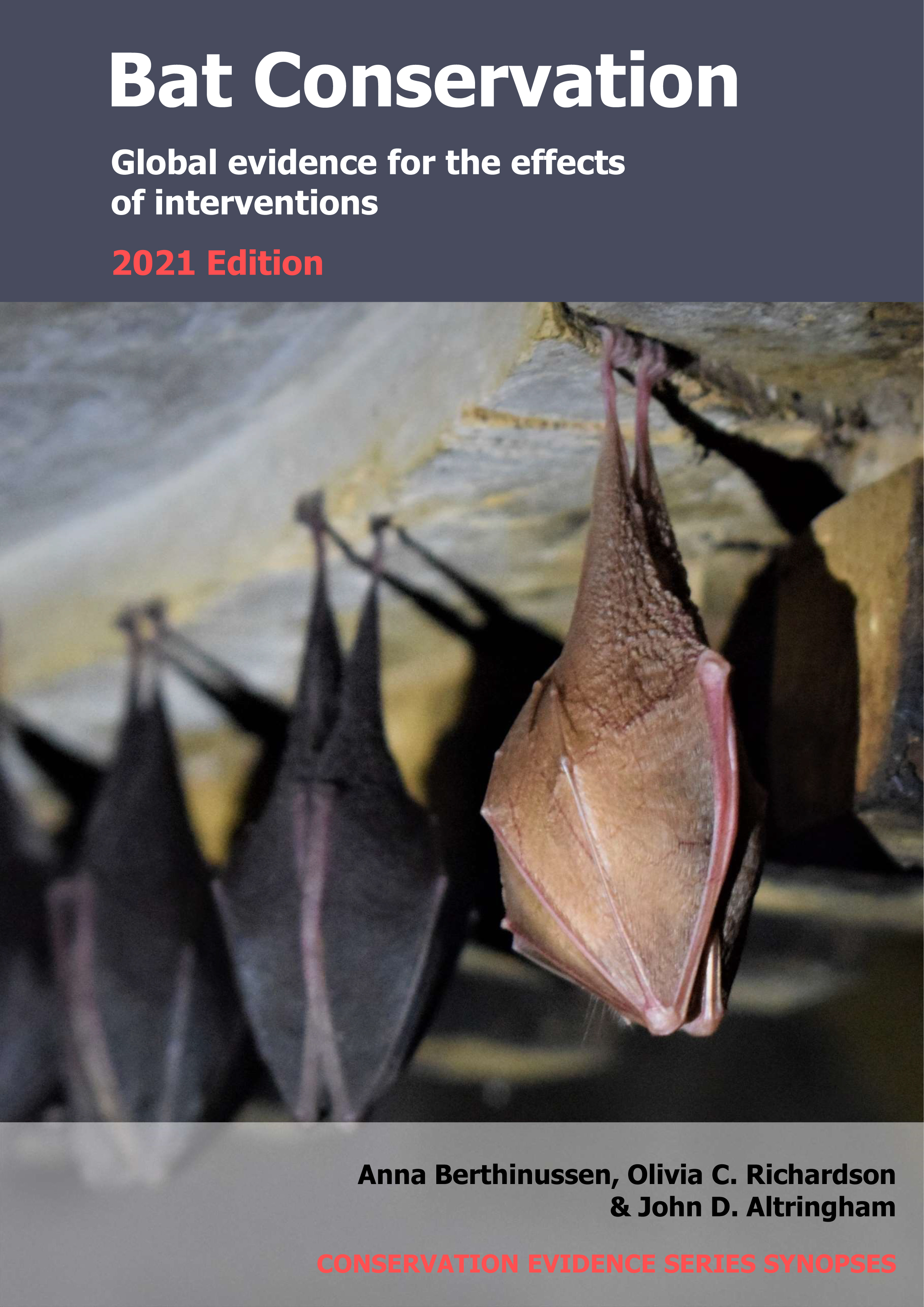Actions to conserve biodiversity
We have summarised evidence from the scientific literature about the effects of actions to conserve wildlife and ecosystems.
Review the evidence from the studies
Not sure what Actions are? Read a brief description.
Search for evidence
e.g. "frogs chytrid"
200 Actions found
Refine
Hide
200 Actions found
Download Actions
| 0 selected |
|
Order results by:
| Action | Effectiveness | Studies | Category | |
|---|---|---|---|---|
|
Retain veteran and standing dead trees as roosting sites for bats Action Link |
No evidence found (no assessment) | 0 |
|
|
|
Retain wetlands Action Link |
No evidence found (no assessment) | 0 |
|
|
|
Slow rotation of turbine blades at low wind speeds Action Link |
Likely to be beneficial | 1 |
|
|
|
Strengthen cultural traditions such as sacred groves that prevent timber harvesting Action Link |
No evidence found (no assessment) | 0 |
|
|
|
Strengthen cultural traditions that discourage bat harvesting Action Link |
No evidence found (no assessment) | 0 |
|
|
|
Thin trees within forest and woodland Action Link |
Likely to be beneficial | 11 |
|
|
|
Train arborists and forestry operatives to identify potential bat roosts Action Link |
No evidence found (no assessment) | 0 |
|
|
|
Train tourist guides to minimize disturbance and promote bat conservation Action Link |
No evidence found (no assessment) | 0 |
|
|
|
Translocate bats Action Link |
Likely to be ineffective or harmful | 2 |
|
|
|
Treat bat hibernacula environments to reduce the white-nose syndrome pathogen reservoir Action Link |
No evidence found (no assessment) | 0 |
|
|
|
Treat bats for infection with white-nose syndrome Action Link |
Unknown effectiveness (limited evidence) | 2 |
|
|
|
Use 'warm white' rather than 'cool' LED lights Action Link |
No evidence found (no assessment) | 0 |
|
|
|
Use collar-mounted devices on cats to reduce predation of bats Action Link |
No evidence found (no assessment) | 0 |
|
|
|
Use glazing treatments to reduce light spill from inside lit buildings Action Link |
No evidence found (no assessment) | 0 |
|
|
|
Use low intensity lighting Action Link |
Likely to be beneficial | 3 |
|
|
|
Use mammal-safe timber treatments in roof spaces Action Link |
No evidence found (no assessment) | 0 |
|
|
|
Use non-lethal measures to prevent bats from accessing fruit in orchards to reduce human-wildlife conflict Action Link |
Likely to be beneficial | 2 |
|
|
|
Use organic farming instead of conventional farming Action Link |
Likely to be beneficial | 12 |
|
|
|
Use organic pest control instead of synthetic pesticides Action Link |
No evidence found (no assessment) | 0 |
|
|
|
Use prescribed burning Action Link |
Trade-off between benefit and harms | 15 |
|
|
|
Use red lighting rather than other lighting colours Action Link |
Likely to be beneficial | 3 |
|
|
|
Use selective or reduced impact logging instead of conventional logging Action Link |
Likely to be beneficial | 4 |
|
|
|
Use shelterwood cutting instead of clearcutting Action Link |
Unknown effectiveness (limited evidence) | 1 |
|
|
|
Use ultraviolet filters on lights Action Link |
Unknown effectiveness (limited evidence) | 1 |
|
|
|
Vaccinate bats against the white-nose syndrome pathogen Action Link |
No evidence found (no assessment) | 0 |
|
Download Actions
| 0 selected |
|

Bat Conservation - Published 2021
Update 2020
Watch this search
If you are familiar with RSS feeds, please click the button below to retrieve the feed URL:
RSS feed for this searchIf you are unfamiliar with RSS feeds, we would suggest reading this BBC article.
Unfortunately, due to the number of feeds we have available, we cannot provide e-mail updates. However, you could use tools such as Feed My Inbox to do this for you.
What are 'Individual studies' and 'Actions'?
Individual studies
An individual study is a summary of a specific scientific study, usually taken from a scientific journal, but also from other resources such as reports. It tells you the background context, the action(s) taken and their consequences.
If you want more detail please look at the original reference.
Actions
Each action page focuses on a particular action you could take to benefit wildlife or ecosystems.
It contains brief (150-200 word) descriptions of relevant studies (context, action(s) taken and their consequences) and one or more key messages.
Key messages show the extent and main conclusions of the available evidence. Using links within key messages, you can look at the paragraphs describing each study to get more detail. Each paragraph allows you to assess the quality of the evidence and how relevant it is to your situation.
Where we found no evidence, we have been unable to assess whether or not an intervention is effective or has any harmful impacts.





)_2023.JPG)














